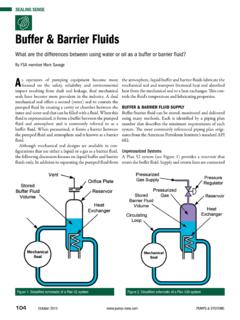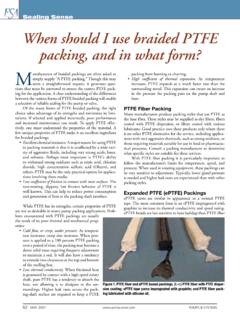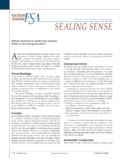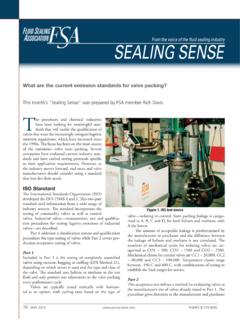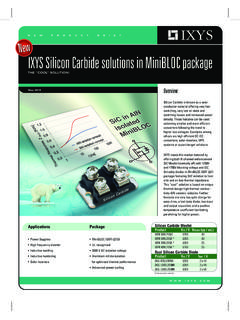Transcription of SEALING SENSE
1 JANUARY 2006 & SYSTEMS64Q. What is the best silicon carbide wear face material for mymechanical seal? carbide (SiC) mechanical seal face material hasbeen available for more than twenty-five is a member of the ceramic face materials family andis considered to be a hard-face material. While most com-monly used against a softer face material, in many applica-tions it can be used against another hard face carbide can be used either as a rotating or sta-tionary face depending upon the seal design, manufacturer,and the other mating face material.
2 Like other mechanicalseal materials and designs, silicon carbide has distinctadvantages as well as some carbide is very hard and has excellent abrasionand wear resistance. It has a low coefficient of friction, highhardness, and high modulus of elasticity. It also retains itsstrength at elevated temperatures, has a low coefficient ofthermal expansion, a high thermal conductivity, and excel-lent corrosion charac-teristics make it anexcellent materialfor mechanical sealfaces, particularlysince it resistsdeflection in high-pressure, high tem-perature, and high-speed pump a ceramicmaterial, on theother hand.
3 Siliconcarbide is quitebrittle and itsmechanicalstrength is less than that of other hard metal carbide facessuch as tungsten carbide . It is susceptible to chipping and/orfracture when placed under mechanical stress or is very common to see silicon carbide placed into ametal holder. Sometimes a metal shroud will be mounted onthe outside diameter of a rotating silicon carbide face to giveit more mechanical strength and prevent catastrophic commonly used metal is Alloy 42 stainless steel, whichwill allow application to temperatures to 750-deg F.
4 Otherstainless steels are and can be used; however, the temperaturelimit is decreased depending on the material being carbide is typically run against a softer face,such as carbon-graphite in many applications. (The indus-try distinguishes carbon as the less crystalline form of theelement, while graphite refers to the more highly crystallineform.)It also runs frequently against tungsten carbide (WC)for a two-hard face material , there are two principal types of silicon carbideproduced: Reaction Bondedand Sintered.
5 Reaction Bonded silicon carbide Reaction Bonded silicon carbide is produced by infil-trating compacts made of silicon carbide and carbon withliquid silicon silicon reacts with the carbon to form silicon car-bide. The reaction product bonds the silicon carbide parti-cles in the compact. It has an inherently impervious struc-ture, so it requiresno corrosionand abrasion resis-tance will varydepending uponthe material s con-tent and distribu-tion of free silicon ,grain size, and freecarbon mechanicalseal manufacturesspecify the free sili-con to be in therange of 8 to12percent andrequire a wear and lubricating characteristics of ReactionBonded silicon carbide are the best of all hard face materi-als.
6 Therefore it is the preferred material for high pressuresand also has good chemical resistance; however, somechemicals will attack the free silicon within the include sodium hydroxide and other caustics,amines, hydrofluoric acid and phosphoric acid containingsmall amounts of hydrofluoric SENSEFrom the voice of the fluid SEALING industryFigure grain structure of reaction bonded silicon carbide with free & SYSTEMS JANUARY 2006 65 Sintered silicon CarbideSintered silicon carbide is the other com-mon type and the most widely used today as ahard face silicon carbide is produced frompure silicon carbide powder with
7 Non-oxidesintering aids. It is a homogeneous form of sil-icon carbide that does not contain any free sil-icon. It also has an impervious structurerequiring no absence of the free silicon makesSintered chemically inert to virtually all corro-sive environments. It is the most resistant tochemically-aggressive fluids and can be used invirtually any fluid. However, it does not havethe pressure-velocity (PV) capabilities of theother type of silicon carbide , and being themost brittle material it tends to chip very types have excellent abrasion resistance and workwell in applications where abrasive particles are present.
8 Theyalso both have low coefficients of friction against most otherface materials, which minimizes the amount of seal face gen-erated , another material, such as tungsten carbide ,should be used as the mating material for the silicon , silicon carbide can be mated with itself in thosecases where the product being sealed has good lubricatingqualities. Also, when using the same material, one of the facesshould be lapped to a different roughness to assure carbide is still readily available for many com-ponent-style seal types, but most new off-the-shelf cartridgeseals for chemical services use sintered silicon carbide as one ofthe face materials for clean services and both faces for in cyclic high pressure applications, two hardfaces with high strength make SENSE .
9 But a careful selectionprocess is necessary because of the consequent reduced carbide versus silicon carbide face combinationsalso are vulnerable to shock loads and can break suddenly ifnot properly SEALING AssociationSealing Senseis produced by the Fluid SEALING Associationaspart of our commitment to industry-consensus technical educationfor pump users, contractors, distributors, OEMs, and reps. As asource of technical information on SEALING systems and devices, andin cooperation with the European SEALING Association, the FSA alsosupports development of harmonized standards in all areas of fluidsealing technology.
10 The education is provided in the public interestto enable a balanced assessment of the most effective solutions topump technology issues on rational Total Life Cycle Cost Mechanical Seal Divisionof the FSA is one of six divisionswith a specific product technology focus. As part of their education-al mission they develop publications such as the Mechanical SealHandbook, a primer intended to complement the more detailed man-ufacturer s documents produced by the member companies. JointFSA/ESA publications such as the Seal Forum, a series of case studiesin pump performance, are another example.
